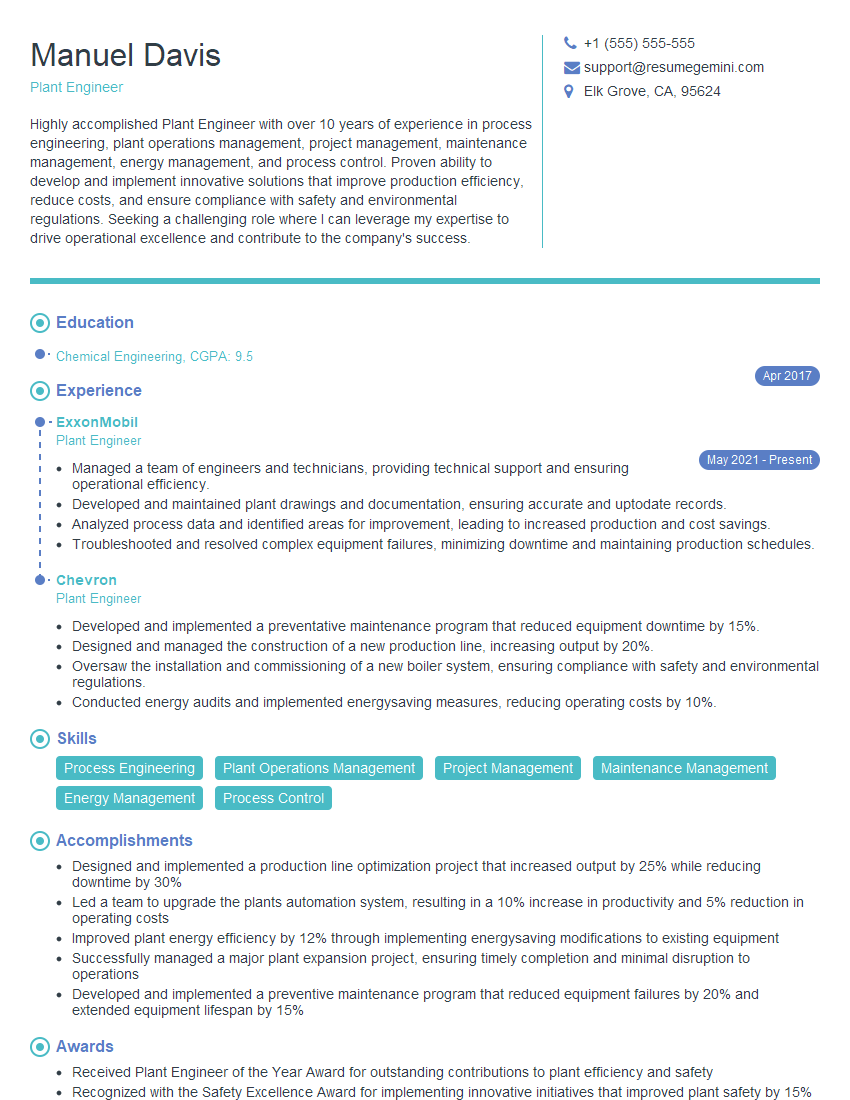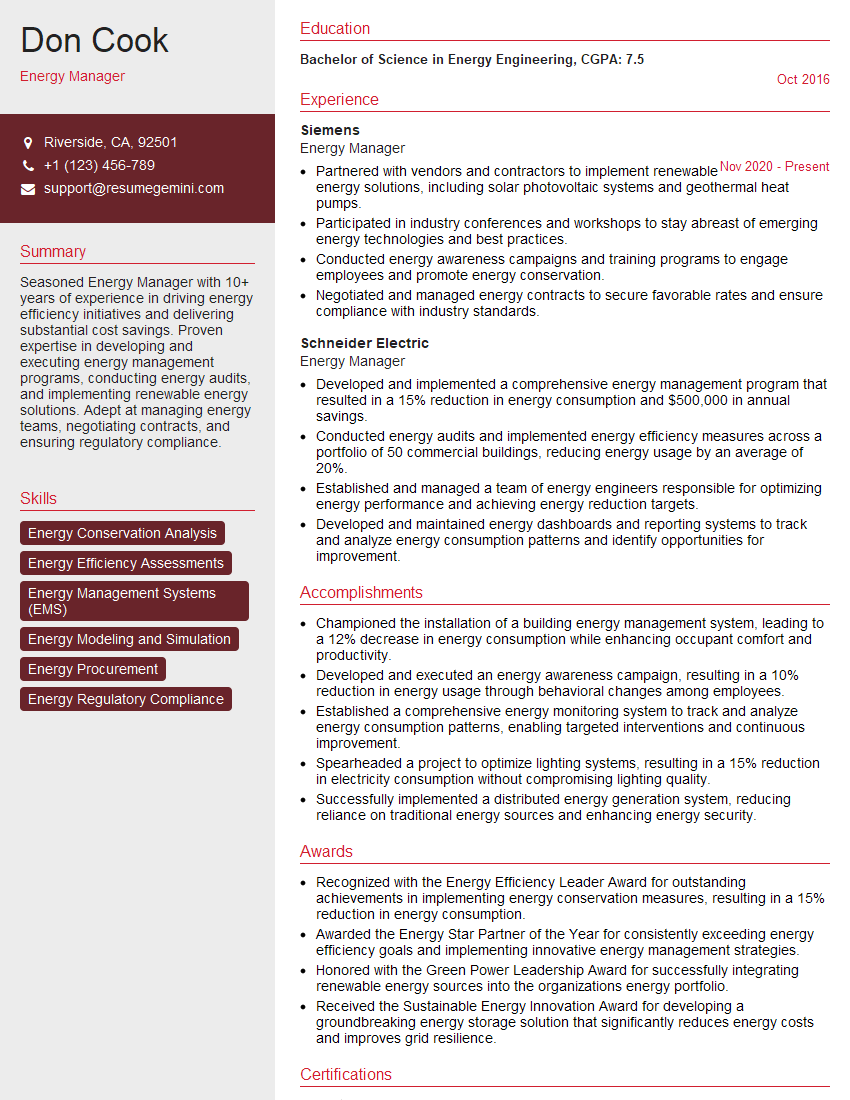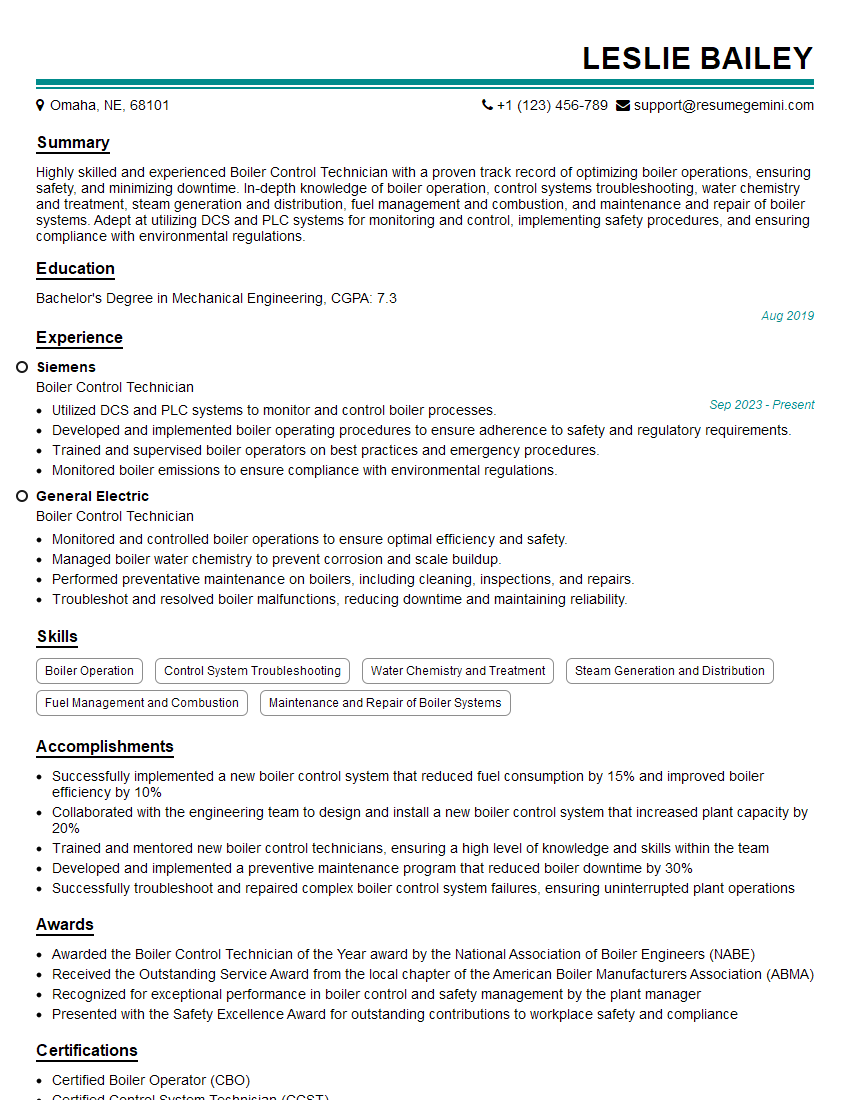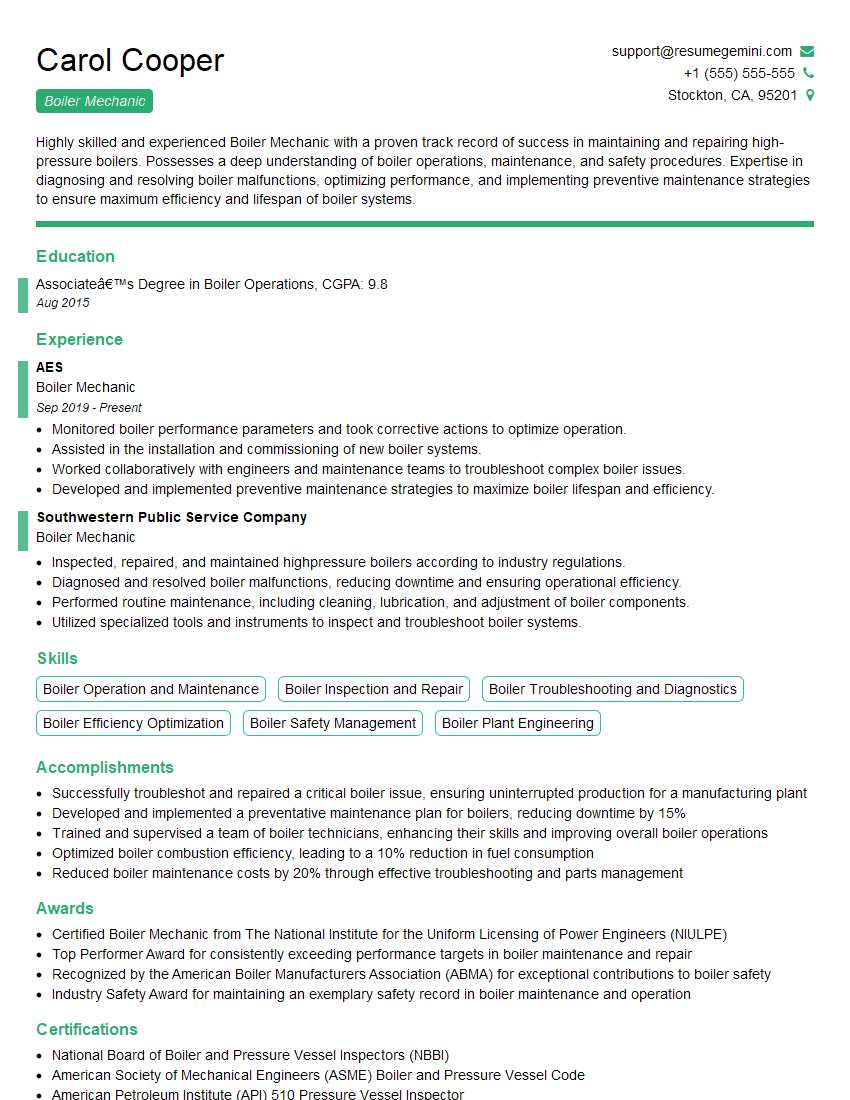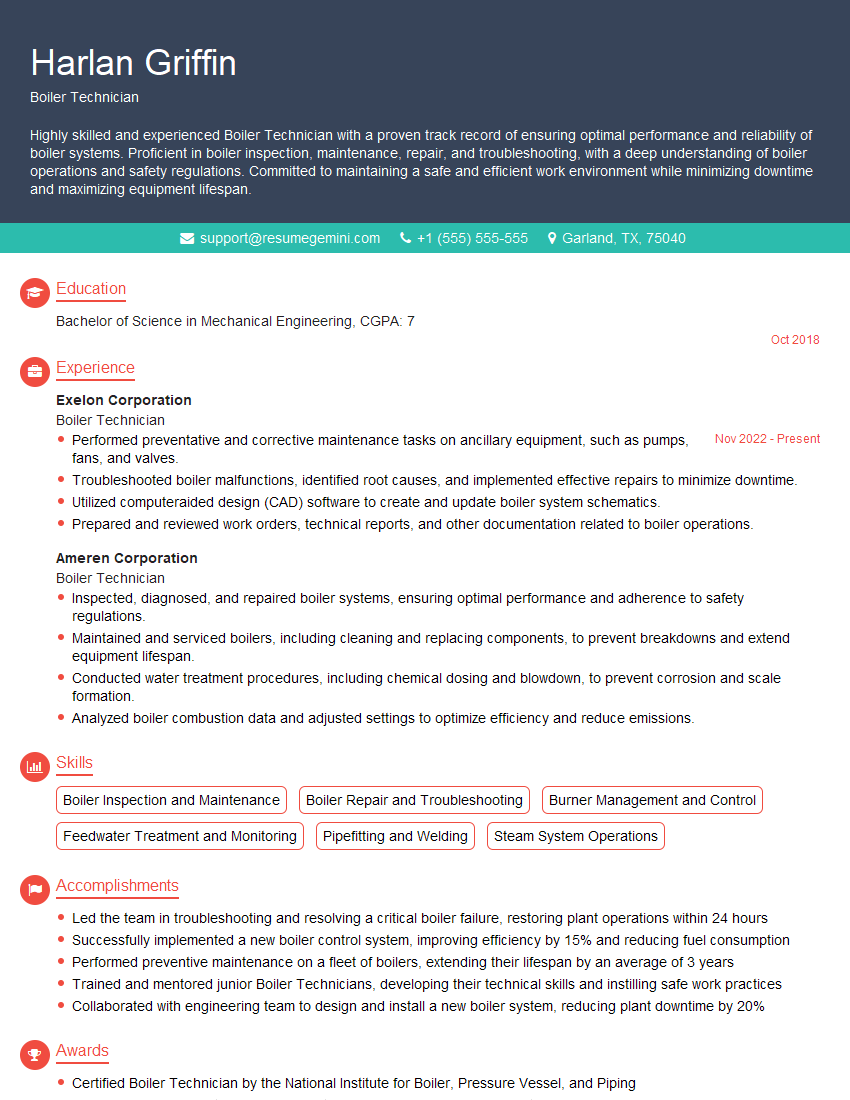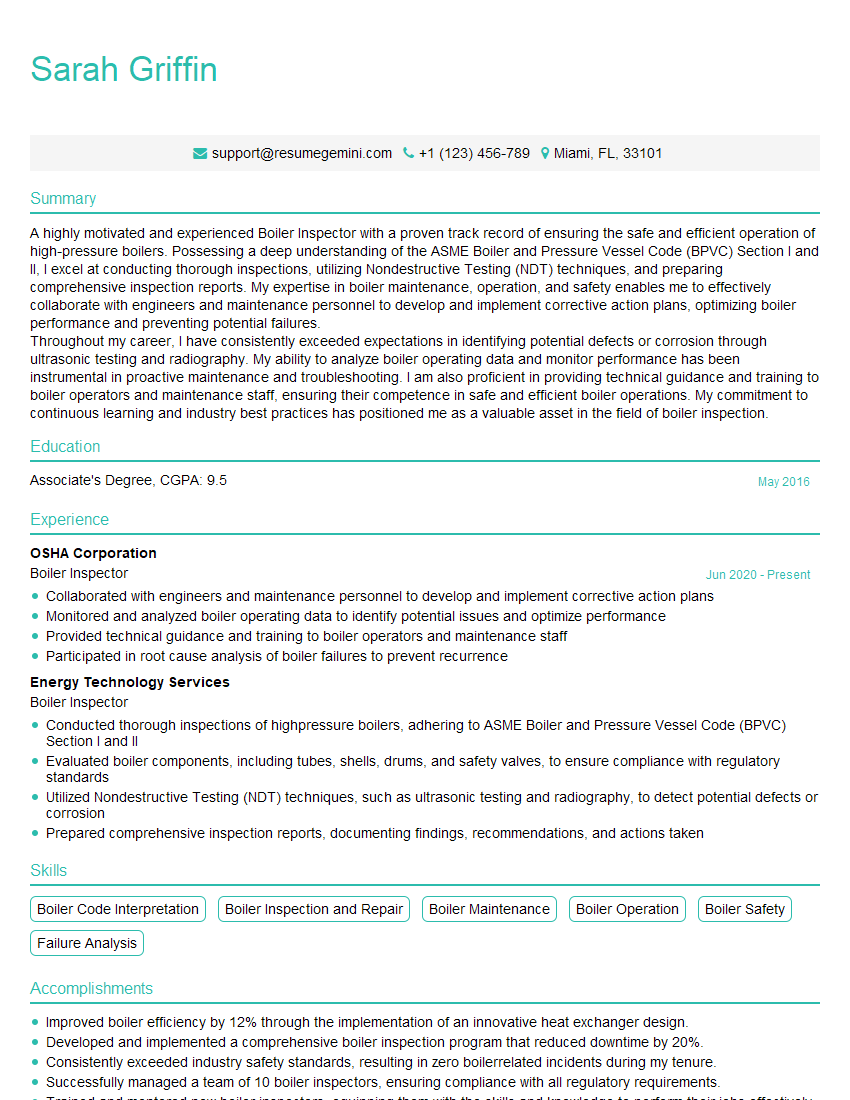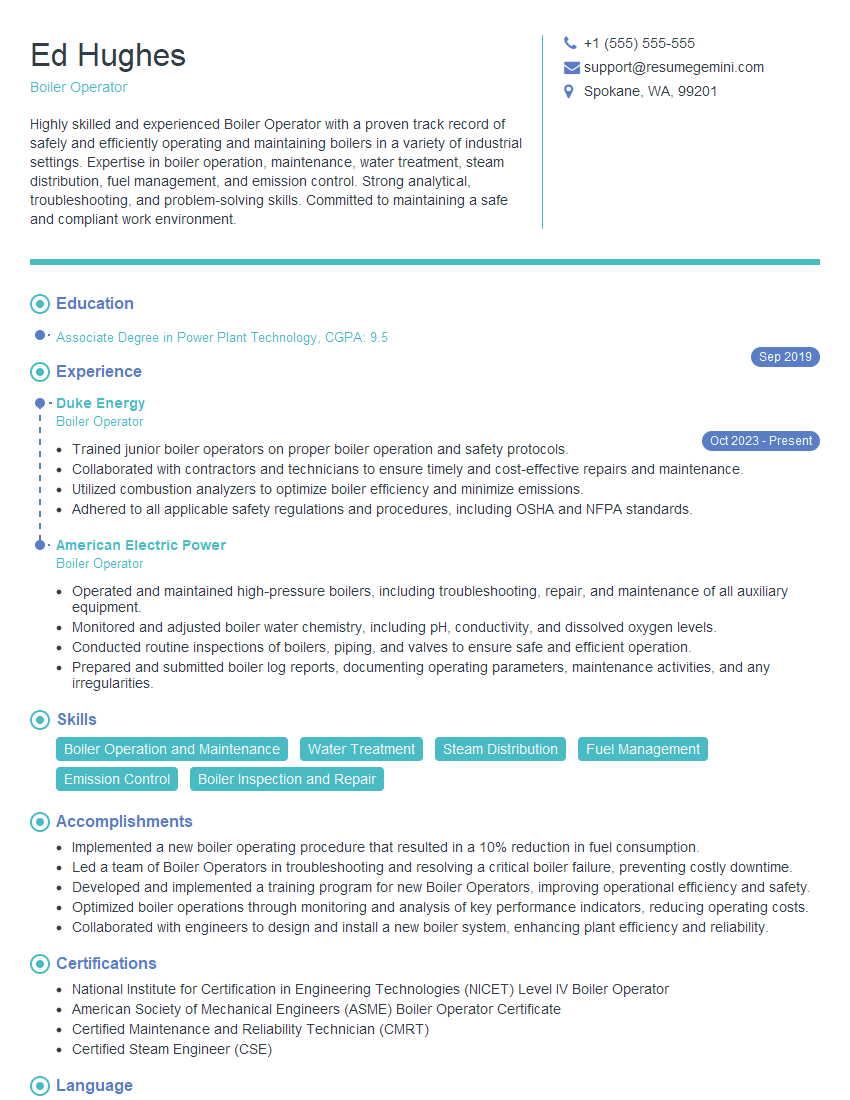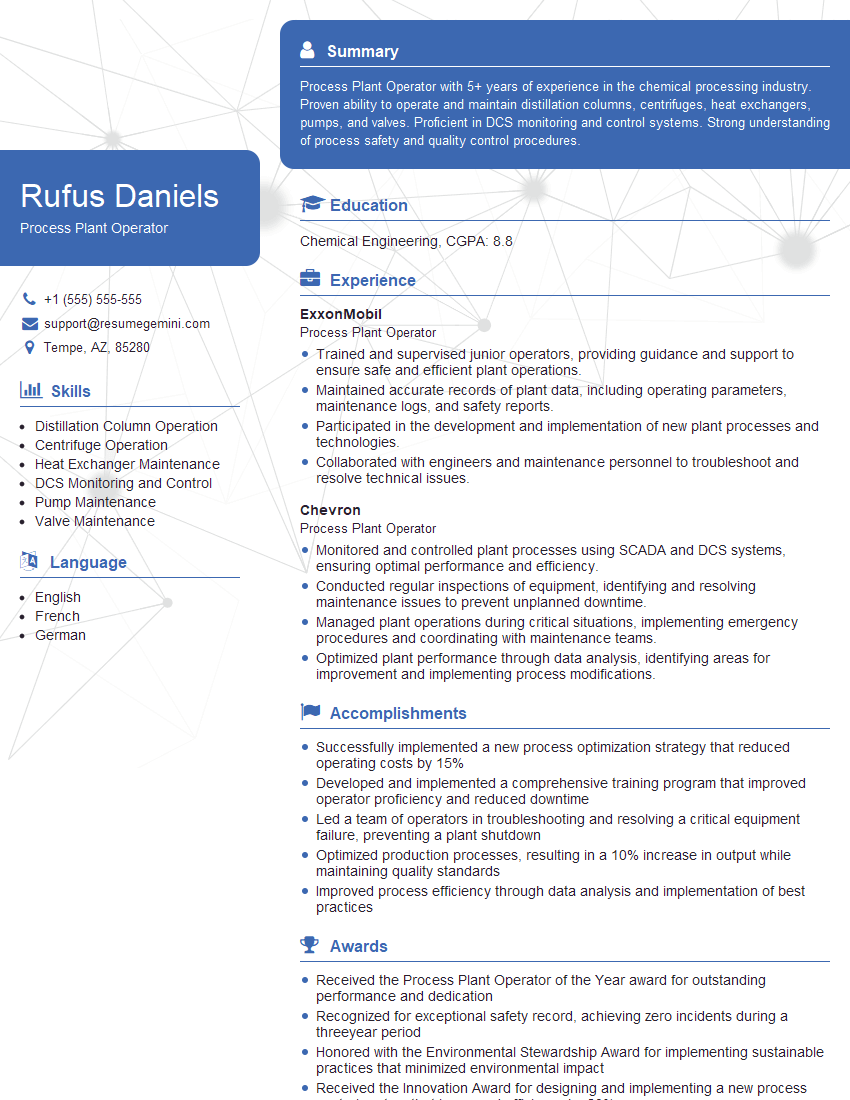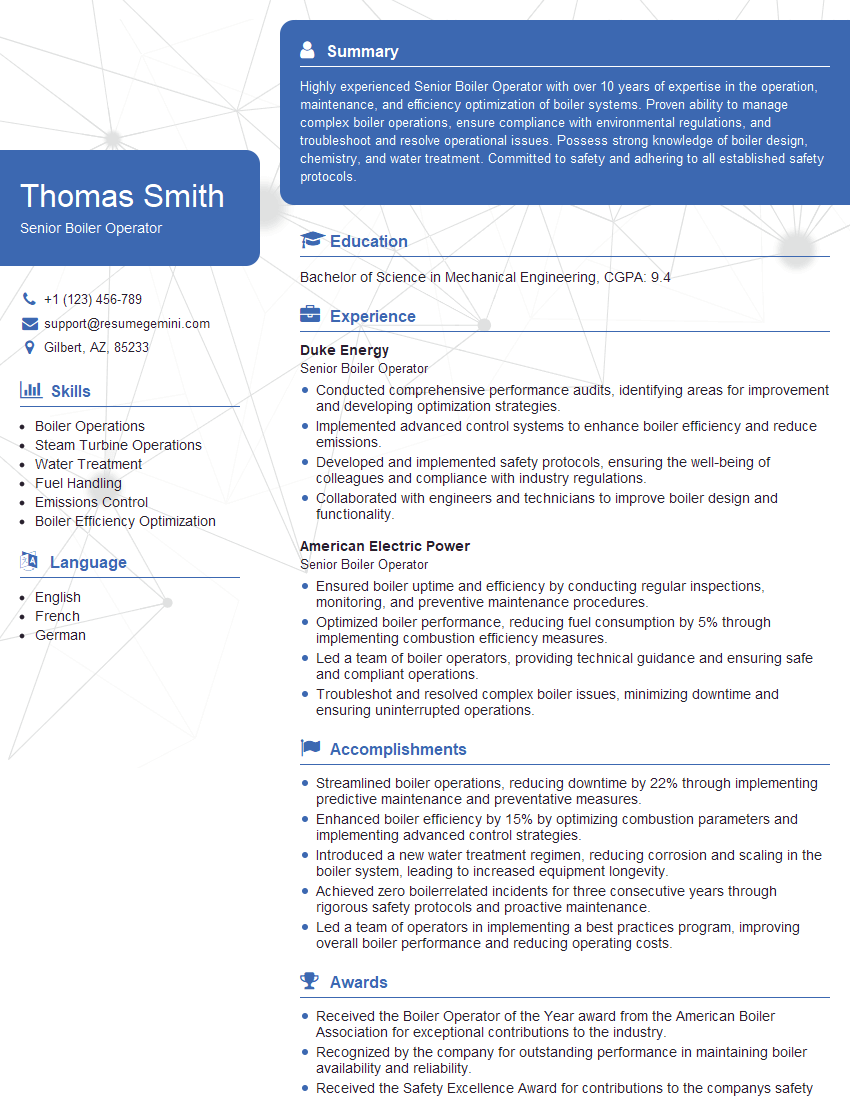Feeling uncertain about what to expect in your upcoming interview? We’ve got you covered! This blog highlights the most important Boilers Operation interview questions and provides actionable advice to help you stand out as the ideal candidate. Let’s pave the way for your success.
Questions Asked in Boilers Operation Interview
Q 1. Explain the different types of boilers and their applications.
Boilers are classified based on various factors, primarily their design and the method of heat transfer. Here are some common types:
- Fire-tube boilers: Hot gases from combustion pass through tubes surrounded by water. They are relatively simple and inexpensive, suitable for smaller applications like heating small buildings or providing hot water for domestic use. Think of it like a tea kettle, but much larger!
- Water-tube boilers: Water circulates through tubes surrounded by hot gases from combustion. These are generally larger, more efficient, and capable of handling higher pressures, often found in power plants and large industrial settings. Imagine a network of pipes carrying water through a furnace.
- Electric boilers: These use electricity to heat water directly, offering clean and quiet operation. They are commonly used in smaller applications where electricity is readily available and cost-effective, such as in smaller commercial settings or homes.
- Packaged boilers: These are pre-assembled units that include the boiler, burner, controls, and other components in a single package. This makes installation easier and faster, common in smaller industrial or commercial settings needing a complete, self-contained unit.
The choice of boiler type depends heavily on the application’s heating requirements, fuel availability, budget, and space constraints. For instance, a large power plant would utilize a high-capacity water-tube boiler, while a small building might use a fire-tube or electric boiler.
Q 2. Describe the water treatment process for boilers.
Boiler water treatment is crucial to prevent scaling, corrosion, and other issues that can severely damage the boiler and reduce its efficiency. The process typically involves several steps:
- Pre-treatment: This involves treating the raw water before it enters the boiler. This could include clarifying, softening (removing hardness minerals like calcium and magnesium), and filtration to remove suspended solids and other impurities.
- Chemical treatment: Once in the boiler, chemicals are added to control water chemistry. These include oxygen scavengers (to prevent corrosion), pH adjusters (to maintain optimal pH), and scale inhibitors (to prevent mineral deposits).
- Blowdown: Periodically, a small amount of boiler water is discharged (blowdown) to remove accumulated solids and maintain the desired concentration of chemicals. This prevents the build-up of impurities that can cause damage.
- Monitoring and analysis: Regular testing of boiler water is essential to monitor its purity and adjust chemical treatment as needed. This ensures the water remains within the specified parameters for safe and efficient boiler operation.
Think of it as keeping your car engine clean and properly lubricated—regular maintenance prevents costly repairs and keeps it running smoothly.
Q 3. How do you monitor boiler water levels and pressure?
Monitoring boiler water levels and pressure is paramount for safe and efficient operation. Several methods are employed:
- Water level gauges: These are visual indicators, typically glass or float-type gauges, that directly show the water level within the boiler drum.
- Pressure gauges: These measure the steam pressure generated by the boiler. Maintaining the correct pressure is crucial for safe and efficient operation, as it’s directly related to steam temperature and energy output.
- Electronic level controls: Modern boilers often use electronic sensors that provide continuous monitoring of water levels and automatically trigger alarms or safety shutdowns if levels fall outside the safe operating range.
- High and low-level alarms: These audible or visual alarms signal when water levels deviate from the safe operating limits, alerting operators to potential problems.
Regular checks and calibrations of these instruments are essential to ensure their accuracy and reliability. Imagine these instruments as the vital signs of the boiler—constant monitoring is key to its health.
Q 4. What are the safety procedures for operating a boiler?
Boiler safety procedures are critical to prevent accidents and injuries. These procedures should be strictly adhered to and include:
- Lockout/Tagout procedures: Before any maintenance or repairs are carried out, the boiler must be completely shut down and locked out to prevent accidental start-up.
- Regular inspections and maintenance: Routine inspections and maintenance are essential to identify potential problems early and prevent failures. This includes checking safety valves, pressure gauges, and other safety devices.
- Emergency shutdown procedures: Operators should be thoroughly trained on emergency shutdown procedures in case of any malfunction or emergency.
- Personal protective equipment (PPE): Appropriate PPE, such as gloves, safety glasses, and hearing protection, should be worn when operating or maintaining boilers.
- Proper ventilation: Adequate ventilation is necessary to prevent the buildup of harmful gases.
Think of these procedures as a comprehensive safety net, protecting both personnel and equipment.
Q 5. Explain the process of boiler start-up and shutdown.
The start-up and shutdown procedures for a boiler are carefully sequenced steps to ensure safety and minimize stress on the system.
Start-up:
- Check water levels and pressure: Ensure the water level is within the specified range and the pressure is at the appropriate level.
- Inspect safety devices: Verify that all safety devices are functioning correctly.
- Purge air from the system: Before firing, air must be purged from the boiler to prevent damage. This may involve opening vents and allowing steam to escape.
- Light the burner: Follow the manufacturer’s instructions for lighting the burner, ensuring a stable flame is established.
- Monitor pressure and temperature: Closely monitor boiler pressure and temperature during the warm-up period, gradually increasing them to the operating levels.
Shutdown:
- Reduce fuel supply: Gradually reduce the fuel supply to the burner, allowing the boiler to cool down slowly.
- Close steam valves: Once the pressure has dropped to a safe level, close the steam valves.
- Monitor pressure and temperature: Continue monitoring pressure and temperature during the cooling down period.
- Drain the boiler: Once the boiler has cooled down, drain any remaining water from the system.
- Clean and inspect: Carry out routine cleaning and inspection of the boiler to maintain it in good condition.
Think of it as carefully warming up and cooling down your car engine – a gradual process protects the engine from damage.
Q 6. How do you identify and troubleshoot common boiler problems?
Troubleshooting boiler problems involves systematically identifying the cause and implementing corrective actions. Common problems and solutions include:
- Low water level: This might indicate a leak, faulty feedwater pump, or excessive blowdown. Check for leaks, inspect the feedwater pump, and adjust blowdown accordingly.
- High pressure: This may be due to a faulty pressure relief valve or excessive firing rate. Check the relief valve and adjust the firing rate to maintain safe pressure.
- Low steam pressure: This might indicate insufficient fuel, scale buildup inside the tubes, or air in the system. Check fuel supply, consider cleaning, and purge air.
- Overheating: This is a serious issue and usually indicates insufficient water circulation, scale buildup, or a faulty safety valve. Immediately shut down the boiler, investigate the cause, and carry out appropriate repairs.
- Corrosion: This can result from low pH, dissolved oxygen, or improper chemical treatment. Adjust chemical treatment to correct water chemistry.
A systematic approach and thorough understanding of boiler operation are essential for effective troubleshooting. Regular maintenance and diligent monitoring are preventative measures that minimize the frequency of these issues.
Q 7. What are the different types of boiler fuel and their efficiency?
Boilers can use a variety of fuels, each with different efficiencies and environmental impacts:
- Natural Gas: A clean-burning fuel with high efficiency and relatively low emissions. Widely used in many boiler applications.
- Fuel Oil: Provides high energy density but has higher emissions than natural gas and requires more sophisticated storage and handling.
- Coal: A cost-effective fuel, especially in some regions, but has significant environmental impacts with high emissions of pollutants and greenhouse gases.
- Biomass: Using renewable sources such as wood chips or agricultural waste is gaining traction as a sustainable fuel option, but efficiency and consistent fuel quality can be challenges.
- Electricity: Clean and efficient, particularly for smaller applications, but electricity costs can be significant.
Efficiency varies depending on the boiler type, design, and fuel used. Modern boilers incorporate technologies to maximize energy extraction and minimize waste. The choice of fuel involves trade-offs between cost, environmental impact, and efficiency. For example, while coal may be cheaper, the environmental concerns might outweigh the cost savings in many instances.
Q 8. Describe the role of boiler controls and instrumentation.
Boiler controls and instrumentation are the nervous system of a boiler system, ensuring safe, efficient, and reliable operation. They monitor critical parameters, automatically adjust operations to maintain optimal conditions, and provide alerts in case of malfunctions. Think of them as the pilot and co-pilot of a plane, constantly monitoring and adjusting to ensure a smooth flight.
Sensors: These constantly monitor key parameters like pressure, temperature, water level, fuel flow, and oxygen levels. Examples include pressure transmitters, thermocouples, level switches, and oxygen analyzers.
Control System: This receives data from sensors, compares it to setpoints (desired values), and actuates control devices to make adjustments. This can be a simple on/off system or a sophisticated PLC (Programmable Logic Controller) with advanced control algorithms. For instance, if water level drops below a setpoint, the control system will automatically activate the feedwater pump.
Actuators: These are the ‘muscles’ of the system, responding to commands from the control system. Examples include valves that regulate fuel flow, damper motors for air control, and pump speed controllers.
Safety Devices: These are crucial for preventing accidents. Examples include high/low pressure safety valves, flame detectors, and low water fuel cutoff switches. A low water fuel cutoff will automatically shut off the fuel supply if the water level gets too low to prevent boiler damage.
Human-Machine Interface (HMI): This provides operators with real-time data visualization and control. Modern HMIs often utilize touchscreen displays and advanced data logging capabilities, offering comprehensive system monitoring and analysis.
Q 9. Explain the importance of boiler maintenance and inspection.
Regular boiler maintenance and inspection are paramount for safety, efficiency, and longevity. Neglecting maintenance is like neglecting a car – it will eventually break down, costing you far more in repairs than regular upkeep. Think of it as preventative medicine for your boiler.
Preventative Maintenance: This includes scheduled tasks like cleaning, inspecting, and replacing worn parts. Regular cleaning of tubes and soot blowers prevents scale buildup and improves heat transfer efficiency. Checking and lubricating moving parts prevents premature wear and tear.
Predictive Maintenance: Using data from sensors and the control system, we can anticipate potential problems before they occur. For example, vibration analysis can detect problems with pumps and fans before they fail catastrophically.
Inspections: Regular inspections by qualified personnel are vital to identify and address potential issues. This includes visual inspection of pressure vessels for cracks and corrosion, as well as thorough checks of all safety devices and control systems.
A well-maintained boiler not only operates more efficiently but also reduces the risk of costly breakdowns and safety hazards. A robust maintenance program is an investment, not an expense.
Q 10. How do you ensure compliance with boiler safety regulations?
Boiler safety regulations vary by region, but generally cover design, construction, operation, and maintenance. Ensuring compliance is a top priority and requires a multifaceted approach.
Regular Inspections and Certification: We must ensure that our boilers are inspected by authorized personnel at the required intervals and obtain the necessary certifications.
Operational Procedures: We need to develop and strictly adhere to detailed written operational procedures that cover startup, shutdown, and normal operation, including emergency procedures. These procedures are critical for safety and must be followed diligently.
Operator Training: Operators must be adequately trained and certified to operate the boilers safely and efficiently, according to all safety regulations and company procedures. Regular refresher training is vital.
Record Keeping: Meticulous record keeping is essential. We maintain detailed logs of all inspections, maintenance activities, and operational data. These records are crucial for demonstrating compliance and for troubleshooting potential problems.
Staying Updated: Boiler safety regulations and best practices are constantly evolving. We must stay informed about changes and ensure that our operations remain compliant.
Compliance is not just about avoiding penalties; it’s about ensuring the safety of personnel and the protection of the environment.
Q 11. What is the purpose of a blowdown process in a boiler?
The blowdown process in a boiler is like regularly cleaning a tea kettle – it removes dissolved solids and impurities from the boiler water. Over time, these impurities concentrate, forming scale and sludge that reduce efficiency and can damage boiler components. These solids can be detrimental to the boiler’s operation and lifespan.
Continuous Blowdown: A small, continuous discharge of water helps maintain a consistent level of dissolved solids. It’s like a slow drip, constantly removing impurities.
Intermittent Blowdown: Periodically, a larger amount of water is discharged to more significantly reduce the concentration of impurities. Think of this as a more thorough cleaning, removing a larger build-up.
Proper blowdown is essential for maintaining boiler efficiency, preventing corrosion, and extending the lifespan of the boiler. Improper blowdown can lead to excessive water and energy loss. The frequency and amount of blowdown depend on water quality and boiler operating conditions.
Q 12. Explain the concept of boiler efficiency and how it’s calculated.
Boiler efficiency is a measure of how effectively the boiler converts fuel energy into usable heat. A high efficiency boiler wastes less fuel, saving money and reducing environmental impact. Imagine two cars traveling the same distance; the one that uses less fuel is more efficient.
Boiler efficiency is typically calculated as:
Efficiency = (Heat Output / Heat Input) x 100%
Heat output is the amount of heat transferred to the water, while heat input is the total energy supplied by the fuel. Measuring heat input and output requires accurate instrumentation, and calculations can vary depending on boiler type. Factors influencing efficiency include boiler design, operating conditions, water quality, and maintenance practices. Regular maintenance and cleaning are crucial to maximizing boiler efficiency.
Q 13. How do you handle boiler emergencies and malfunctions?
Handling boiler emergencies and malfunctions requires a calm, methodical approach. Prior preparation is crucial for a swift and safe response.
Emergency Procedures: We must have well-defined emergency procedures readily available, covering various scenarios like low water levels, high pressure, flame failures, and power outages. These procedures should be practiced regularly.
Safety First: The immediate priority is always to ensure the safety of personnel. Evacuate the area if necessary and alert emergency services.
Isolate the Problem: Identify and isolate the source of the malfunction to prevent further damage or escalation of the problem. This may involve shutting down the boiler and isolating fuel and power supplies.
Troubleshooting: Attempt to identify the cause of the problem using the available instrumentation and diagnostic tools. The historical data from the HMI is critical in understanding the root cause.
Repair and Restart: Once the problem is resolved, and all safety checks are completed, the boiler can be restarted according to the established procedures.
Post-Incident Review: After any major incident, a thorough review is carried out to identify contributing factors and prevent future occurrences.
Regular maintenance and proactive monitoring reduce the likelihood of emergencies, but having clear procedures and well-trained personnel is crucial for managing those that do occur.
Q 14. What is the function of a boiler feedwater pump?
The boiler feedwater pump is the heart of the boiler system, responsible for delivering water to the boiler at the required pressure and flow rate. It maintains the water level in the boiler and ensures a continuous supply of water to replace the steam generated. Think of it as the circulatory system of the boiler, ensuring continuous flow.
The pump’s performance is critical for safe and efficient operation. Insufficient flow rate can lead to low water levels and potential damage to the boiler, while excessive pressure can lead to system failures. Regular maintenance and monitoring of the pump’s performance are therefore vital.
Q 15. Describe the different types of boiler burners and their operation.
Boiler burners are the heart of the system, responsible for igniting and mixing fuel with air to create combustion and generate heat. Different types cater to various fuels and boiler sizes. Here are some common types:
- Oil Burners: These utilize atomized oil, sprayed into the combustion chamber, creating a fine mist for efficient burning. Different atomization methods exist, including pressure atomization and rotary cup atomization. Think of it like a highly controlled spray bottle, but instead of water, it’s fuel oil. Regular maintenance, including nozzle cleaning, is critical for efficient and clean combustion.
- Gas Burners: These utilize natural gas or propane, mixed with air before ignition. They’re often more efficient than oil burners and require less maintenance. Think of it as a precisely controlled gas stove, but on a much larger scale. The air/fuel ratio is crucial for optimal combustion.
- Coal Burners: These are used in larger industrial boilers, feeding pulverized coal into the combustion chamber. They are complex, requiring sophisticated controls for efficient combustion and emission management. This type involves significantly more complex processes to ensure even burning and minimize ash buildup.
- Combination Burners: Some boilers can use multiple fuel types, offering flexibility depending on fuel availability and cost. This allows for redundancy and adaptability to changing market conditions.
The operation of any burner involves precise control of the air-fuel ratio, ignition, and flame stabilization to maximize efficiency and minimize emissions. Advanced burners use sophisticated control systems to monitor and adjust these parameters in real-time.
Career Expert Tips:
- Ace those interviews! Prepare effectively by reviewing the Top 50 Most Common Interview Questions on ResumeGemini.
- Navigate your job search with confidence! Explore a wide range of Career Tips on ResumeGemini. Learn about common challenges and recommendations to overcome them.
- Craft the perfect resume! Master the Art of Resume Writing with ResumeGemini’s guide. Showcase your unique qualifications and achievements effectively.
- Don’t miss out on holiday savings! Build your dream resume with ResumeGemini’s ATS optimized templates.
Q 16. What are the signs of boiler scale and how do you address it?
Boiler scale is a hard, mineral deposit that forms on the inside surfaces of boiler tubes and other components. It’s primarily composed of calcium and magnesium salts, which precipitate out of the water as it heats up. Think of it as a build-up of limescale in your kettle, but on a much larger and more problematic scale.
- Reduced Heat Transfer: Scale acts as an insulator, reducing the boiler’s efficiency and increasing fuel consumption. The heat isn’t transferred as effectively to the water, requiring more energy to achieve the desired temperature.
- Overheating and Tube Failure: The insulating effect of scale can cause localized overheating of boiler tubes, leading to potential failure and costly repairs or even explosions. This is a serious safety hazard.
- Increased Pressure Drop: Scale buildup restricts water flow, increasing pressure drop and reducing boiler capacity. The boiler will struggle to deliver the required steam or hot water flow.
- Corrosion: Under certain water conditions, scale can actually promote corrosion by creating concentration cells on the boiler’s surface.
Addressing boiler scale requires a multi-pronged approach:
- Regular Water Treatment: Implementing proper water treatment programs using chemicals like chelating agents and dispersants prevents scale formation. This is preventative maintenance, the most cost-effective way to handle scale.
- Chemical Cleaning: If scale has already formed, chemical cleaning agents can dissolve and remove it. This is usually carried out during scheduled shutdowns.
- Mechanical Cleaning: In severe cases, mechanical cleaning methods like brushing or scraping might be necessary, but this is disruptive and should be a last resort.
The best approach is proactive prevention through consistent water treatment.
Q 17. Explain the importance of proper boiler water chemistry.
Proper boiler water chemistry is paramount for safe and efficient boiler operation. It ensures the prevention of scale formation, corrosion, and other problems that can lead to costly repairs and downtime. It’s like giving your boiler a healthy diet and regular check-ups.
- Corrosion Prevention: Maintaining the correct pH and controlling the levels of dissolved oxygen and other corrosive substances prevent metal degradation in boiler tubes and other components, extending their lifespan.
- Scale Prevention: As discussed earlier, proper water treatment prevents the formation of scale, improving efficiency and preventing overheating.
- Foaming and Priming Control: Proper water treatment minimizes foaming and priming, which can lead to carryover of water droplets into the steam system. Foaming is like the froth in a boiling pot of water; priming is like the pot suddenly spitting out the water.
- Boiler Efficiency: By preventing scale and corrosion, proper water chemistry optimizes heat transfer and improves boiler efficiency, reducing fuel costs.
- Safety: Preventing scale, corrosion, and other problems related to poor water chemistry is crucial for safe boiler operation, avoiding potential failures and accidents.
Regular water testing and adjustments to chemical treatment are essential to maintain optimal boiler water chemistry. This usually involves monitoring parameters like pH, conductivity, alkalinity, and dissolved oxygen.
Q 18. How do you perform a boiler inspection?
Boiler inspection is a crucial part of preventative maintenance, ensuring safety and efficient operation. A thorough inspection involves a systematic examination of various components.
- External Inspection: Checking the boiler’s exterior for any signs of leaks, damage, or corrosion. This includes examining the casing, insulation, valves, and piping.
- Internal Inspection: This is usually done during scheduled shutdowns and often involves visual inspection through access ports. It involves checking for scale buildup, corrosion, and any other internal damage to the tubes and other components. Specialized equipment like borescopes can provide detailed images of hard-to-reach areas.
- Pressure Testing: A hydrostatic pressure test checks for leaks in the boiler’s pressure-bearing components. Water is used to pressurize the boiler to a level above its operating pressure to check for any weaknesses.
- Valve and Safety Device Inspection: This includes checking the functionality of all safety valves, pressure gauges, and other safety devices.
- Documentation: All findings are carefully documented, including any necessary repairs or replacements. A detailed inspection report serves as a record for future maintenance scheduling.
The frequency of inspections depends on the boiler’s age, type, operating conditions, and local regulations. Regular inspections are vital for identifying and addressing potential problems before they lead to failures or accidents.
Q 19. What are the different types of boiler safety valves and their functions?
Boiler safety valves are critical safety devices that automatically release excess pressure from the boiler if it exceeds a predetermined limit, preventing dangerous explosions. Several types exist:
- Spring-Loaded Safety Valves: These are the most common type, using a spring to hold the valve closed until the pressure exceeds the set point. The valve opens to release steam, reducing pressure, then closes automatically when the pressure falls below the set point. Imagine it like a pressure relief valve on a pressure cooker.
- Weight-Loaded Safety Valves: These use weights to balance the pressure in the boiler. If the pressure exceeds the weight’s capacity, the valve opens. These are less common now due to their complexity and limitations compared to spring-loaded valves.
- Pilot-Operated Safety Valves: These use a small pilot valve to open the main safety valve, allowing for faster response and reduced pressure buildup. They’re useful for high-pressure boilers requiring faster response times.
- Dual Safety Valves: Often required in high-pressure or high-capacity systems, this involves having two safety valves installed, providing redundancy and increased safety.
Each valve’s function is to prevent over-pressurization and potential catastrophic failures. Regular testing and maintenance are essential to ensure they operate reliably when needed.
Q 20. How do you interpret boiler performance data?
Boiler performance data provides valuable insights into efficiency, safety, and potential problems. Analyzing this data allows for optimization and preventative maintenance. Key parameters include:
- Fuel Consumption: Monitoring fuel consumption helps identify any inefficiencies and allows for comparison against historical data and benchmarks.
- Steam or Hot Water Production: Tracking steam or hot water production relative to fuel consumption provides a measure of boiler efficiency.
- Pressure and Temperature: Consistent monitoring of pressure and temperature is crucial for safe and efficient operation. Significant deviations can indicate potential problems.
- Efficiency: Boiler efficiency can be calculated by comparing the energy output to the energy input. This helps identify areas for improvement.
- Blowdown Rates: Monitoring blowdown rates helps assess the effectiveness of water treatment programs and identify potential issues related to solids buildup.
- Emission Levels: Monitoring emissions is important for environmental compliance. Abnormal levels might indicate combustion inefficiencies or equipment problems.
Using data analysis techniques, patterns and trends can be identified, enabling proactive maintenance and optimization of the boiler system. Sophisticated control systems and data loggers can streamline data collection and analysis.
Q 21. Describe your experience with different types of boiler controls (e.g., PLC, DCS).
My experience encompasses various boiler control systems, from simpler pneumatic and electromechanical systems to advanced Programmable Logic Controllers (PLCs) and Distributed Control Systems (DCSs).
- Pneumatic Controls: I’ve worked with older systems using pneumatic actuators and controllers, understanding their limitations and the need for careful calibration and maintenance. These systems were more basic but provided a level of reliability in simple setups.
- Electromechanical Controls: These systems use a combination of electrical sensors and mechanical components for control. They provide improved precision and reliability over purely pneumatic systems. This typically involved a higher level of troubleshooting knowledge and understanding of analog systems.
- PLCs (Programmable Logic Controllers): I’ve extensively used PLCs to control complex boiler systems. PLCs offer flexibility, allowing for complex control strategies and data logging capabilities. I’m proficient in programming PLCs using various languages, such as Ladder Logic, to implement customized control solutions and integrate with supervisory systems.
Example code snippet (Ladder Logic): IF (Pressure > Setpoint) THEN (Open Safety Valve) - DCSs (Distributed Control Systems): In larger industrial applications, I’ve worked with DCSs that provide integrated control and monitoring of multiple boilers and other plant equipment. DCSs offer advanced capabilities such as redundancy, advanced process control algorithms, and centralized operator interfaces. They provide the most comprehensive approach to boiler control and monitoring.
My experience includes configuring, troubleshooting, and maintaining these different types of control systems, ensuring optimal boiler performance, safety, and efficiency. The choice of control system is dependent on the size, complexity, and specific needs of the boiler installation.
Q 22. Explain your experience with boiler combustion optimization.
Boiler combustion optimization is crucial for maximizing efficiency and minimizing fuel consumption while reducing harmful emissions. It involves fine-tuning the boiler’s operational parameters to achieve the optimal balance between air and fuel. This process usually begins with a thorough understanding of the current boiler operation through data analysis of key performance indicators (KPIs).
- Air-Fuel Ratio Adjustment: Precise control of the air-fuel ratio is paramount. Too much air leads to wasted energy, while insufficient air results in incomplete combustion and increased pollutant formation (like carbon monoxide). Modern boilers often employ advanced control systems that continuously monitor and adjust this ratio based on oxygen levels in the flue gas. I’ve used these systems extensively, and I can troubleshoot issues in their control loops as needed.
- Burner Optimization: The efficiency of the burner itself greatly impacts combustion. Regular maintenance, including cleaning and adjusting flame patterns, is critical. I’ve experienced firsthand how a poorly adjusted burner can lead to significant energy loss and increased emissions. For example, I once worked on a boiler where improper burner alignment caused uneven heat distribution, which was resolved through careful realignment and subsequent monitoring of heat transfer efficiency.
- Excess Air Control: By optimizing the excess air level through stack gas analysis, we can significantly reduce heat loss through the exhaust and cut down on NOx emissions. Lowering excess air requires a delicate balance; too little air leads to incomplete combustion and soot formation.
In my previous role, I implemented a combustion optimization project that resulted in a 15% reduction in fuel consumption and a noticeable decrease in NOx emissions, saving the company a substantial amount of money annually and improving their environmental impact. This involved a combination of improved control strategies, burner maintenance and regular performance testing and adjustments.
Q 23. How do you troubleshoot boiler leaks?
Troubleshooting boiler leaks requires a systematic approach, starting with safety. Always ensure the boiler is depressurized and locked out/tagged out before attempting any repairs. The next step is identifying the leak’s location and severity.
- Visual Inspection: A careful visual inspection is often the first step. Look for obvious signs of water or steam leaks, such as dripping, wet spots, or hissing sounds.
- Pressure Testing: If the leak is not immediately apparent, a pressure test can help pinpoint the source. This involves pressurizing the boiler system with air or water (depending on the boiler design) and carefully observing for pressure drops or escaping fluids. This often requires specialised testing equipment and should be handled only by qualified personnel.
- Dye Penetrant Testing: This non-destructive method can reveal even hairline cracks in metal components. A dye is applied to the surface, and after a period of time, a developer is used to reveal any cracks where the dye has penetrated.
- Ultrasonic Testing: Ultrasonic testing uses sound waves to detect internal flaws in the boiler’s metal components, such as corrosion or cracks within the boiler tubes. This method is particularly useful for finding leaks that are hidden from view.
For instance, I once encountered a persistent leak in an older boiler that proved difficult to locate using standard visual methods. By employing dye penetrant testing, we identified a small crack in a weld joint that had been masked by accumulated scale. After successfully repairing the crack, we then implemented a preventative maintenance schedule to minimize future occurrences.
Q 24. Describe your experience with boiler tube cleaning and maintenance.
Boiler tube cleaning and maintenance are critical for maintaining efficiency and preventing costly failures. The frequency and methods depend on the type of boiler, fuel used, and water quality.
- Water Treatment: Proper water treatment is essential to prevent scale buildup and corrosion within the boiler tubes. This includes using chemicals to soften water and control pH.
- Mechanical Cleaning: Mechanical cleaning methods, such as using brushes, scrapers, or specialized tools to remove scale and deposits from the inside of the boiler tubes, are frequently used. I have experience with various techniques, from manual cleaning to more automated methods that deploy robotic systems.
- Chemical Cleaning: Chemical cleaning involves using specialized solutions to dissolve scale and other deposits. This method is often used to clean extensively fouled tubes.
- Hydro-testing: After any significant cleaning procedure, pressure hydro-testing confirms the tube’s integrity. It ensures that the cleaning process didn’t introduce any new damage to the metal.
In one case, neglecting routine tube cleaning led to a significant reduction in boiler efficiency. By implementing a regular cleaning schedule along with modifications to the water treatment regimen, we restored the boiler’s performance and extended its operational life. This also allowed for a more proactive approach to identifying and mitigating possible issues.
Q 25. What safety precautions do you take when working around high-pressure steam?
Working with high-pressure steam demands rigorous adherence to safety protocols. The potential for serious injury from burns, explosions, or scalding is substantial.
- Lockout/Tagout Procedures: Before any work is performed on a high-pressure steam system, the system must be completely depressurized, isolated, and locked out/tagged out to prevent accidental activation. This is crucial to ensure operator safety.
- Personal Protective Equipment (PPE): Appropriate PPE is essential, including heat-resistant gloves, safety glasses, and face shields. In situations with high-pressure steam, specialized protective clothing and equipment are often necessary.
- Steam Traps and Valves: Regular inspection and maintenance of steam traps and valves are vital to prevent steam leaks and ensure the safe operation of the system.
- Emergency Procedures: Emergency procedures must be clearly defined and well understood by all personnel involved. This includes knowing the location of emergency shut-off valves and emergency response plans in case of an incident.
During my career, I have consistently emphasized safety training and proper protocols. By maintaining a safety-first mindset, we’ve been able to avoid accidents, preventing serious injuries and protecting both personnel and equipment.
Q 26. What is your experience with different types of boiler fuel (e.g., natural gas, oil, coal)?
I possess extensive experience with various boiler fuels, including natural gas, oil, and coal. Each fuel type presents unique operational considerations.
- Natural Gas: Natural gas is a relatively clean-burning fuel and is widely used in boilers due to its efficiency and reduced emissions. However, proper gas pressure regulation and flame monitoring are critical to optimal performance.
- Oil: Oil-fired boilers require careful monitoring of fuel quality and atomization to ensure efficient combustion. Regular cleaning of fuel lines and burners is necessary to prevent clogging and ensure optimal efficiency.
- Coal: Coal-fired boilers are typically larger and more complex than gas or oil-fired boilers. They require sophisticated systems for coal handling, ash removal, and emission control. Coal quality significantly impacts boiler performance and maintenance needs.
My experience spans across all three fuel types. I’ve worked on projects involving the conversion of coal-fired boilers to natural gas, improving efficiency and reducing emissions. I understand the specific challenges and operational considerations associated with each fuel, from fuel storage and handling to combustion optimization and emission control.
Q 27. Explain your experience with environmental regulations related to boiler emissions.
Compliance with environmental regulations concerning boiler emissions is paramount. These regulations vary by location and often focus on limiting emissions of pollutants like NOx, SOx, particulate matter (PM), and CO.
- Emission Monitoring: Regular monitoring of boiler emissions is necessary to ensure compliance with environmental regulations. This often involves using Continuous Emission Monitoring Systems (CEMS) to measure pollutant concentrations in the flue gas.
- Emission Control Technologies: Various technologies are available to reduce boiler emissions, including low-NOx burners, selective catalytic reduction (SCR), and selective non-catalytic reduction (SNCR). I have experience in designing, implementing, and maintaining these systems.
- Permitting and Reporting: Boiler operators must obtain necessary permits and submit regular emission reports to the relevant authorities. Understanding and adhering to these requirements is critical to avoid penalties.
In my previous role, I was instrumental in helping our facility achieve compliance with stringent new emission regulations through the installation of an SCR system and the optimization of our combustion processes. This required a detailed understanding of the regulations, the selection of appropriate control technologies, and careful monitoring of the system’s performance.
Q 28. Describe your experience with boiler automation and control systems.
Boiler automation and control systems play a crucial role in optimizing boiler performance, improving efficiency, and enhancing safety. These systems use sensors, actuators, and programmable logic controllers (PLCs) to monitor and control various boiler parameters.
- PLC Programming: I have extensive experience in programming and troubleshooting PLCs used in boiler control systems. This includes ladder logic programming, HMI design, and data acquisition system setup.
- Distributed Control Systems (DCS): I am familiar with various DCS platforms and their application in managing large and complex boiler systems. These systems offer advanced functionalities like predictive maintenance and automated fault detection.
- Supervisory Control and Data Acquisition (SCADA): SCADA systems provide a centralized platform for monitoring and controlling multiple boilers and other plant equipment. This facilitates real-time monitoring of key parameters and remote access for troubleshooting.
For example, I once helped upgrade an older boiler system with a modern DCS, which significantly improved its efficiency and reduced downtime. The new system incorporated advanced control algorithms, improved data logging capabilities, and facilitated predictive maintenance, leading to substantial cost savings. The system incorporated detailed historical data logging and provided alerts for predictive maintenance, allowing for timely intervention and preventive measures.
Key Topics to Learn for Boilers Operation Interview
- Boiler Types and Fundamentals: Understanding different boiler types (fire-tube, water-tube, etc.), their operating principles, and key components like burners, feedwater systems, and safety devices.
- Combustion and Fuel Efficiency: Mastering the principles of combustion, including stoichiometry, air-fuel ratio adjustments, and the impact on efficiency and emissions. Practical application involves troubleshooting issues related to incomplete combustion and optimizing fuel consumption.
- Water Treatment and Chemistry: Knowledge of water treatment processes to prevent scaling, corrosion, and other issues impacting boiler efficiency and longevity. This includes understanding water quality parameters and their significance.
- Steam Generation and Distribution: Understanding the process of steam generation, its properties (pressure, temperature, dryness fraction), and the distribution system to ensure efficient and safe delivery to end-users.
- Boiler Controls and Instrumentation: Familiarity with various control systems (PLC, DCS), instrumentation (level, pressure, temperature sensors), and their role in maintaining safe and efficient boiler operation. Troubleshooting malfunctions within these systems is crucial.
- Safety and Regulatory Compliance: Understanding relevant safety regulations, operating procedures, and emergency protocols to ensure safe operation and compliance with industry standards. This includes lockout/tagout procedures and emergency shutdown protocols.
- Troubleshooting and Maintenance: Developing problem-solving skills to diagnose and resolve common boiler issues. Practical experience with preventative maintenance schedules and procedures will be highly beneficial.
- Energy Efficiency and Optimization: Understanding strategies for optimizing boiler efficiency, reducing energy consumption, and minimizing environmental impact.
Next Steps
Mastering Boilers Operation opens doors to rewarding and challenging careers in power generation, industrial processing, and other vital sectors. To stand out from the competition, create a compelling, ATS-friendly resume that showcases your skills and experience effectively. ResumeGemini is a trusted resource that can help you build a professional resume tailored to your specific goals. Examples of resumes tailored to Boilers Operation are available to guide you.
Explore more articles
Users Rating of Our Blogs
Share Your Experience
We value your feedback! Please rate our content and share your thoughts (optional).
What Readers Say About Our Blog
This was kind of a unique content I found around the specialized skills. Very helpful questions and good detailed answers.
Very Helpful blog, thank you Interviewgemini team.
